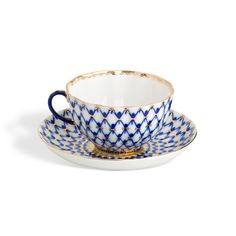
There is something very appealing about an assortment of Blue and White China. No matter if it is new or old, English, Italian, Chinese or Dutch, it all goes together beautifully in an eclectic, timeless collection. Blue and white porcelain in a home create an everlasting, classic quality perfect for any country styled afternoon or morning tea, kitchen or room decor.

The enduring Blue Willow Pattern originates from China, home to the finest porcelain. The magnificent tradition of blue and white porcelain began during the Yuan dynasty in the early 1300s, with the pigment cobalt blue being used for decorative purposes. It became more popular in the Ming dynasty 1368–1644 because the market for fine porcelain spread from imperial and nobleman to the general public in China and overseas. Across the world, in England and Europe, a tradition of ‘laying the table with ‘the good china’ was a regular domestic activity that continued until well into the 20th century. The Chinese designs were sort after, and The Willow Pattern is a by-product of this. It was designed in 1780 by Thomas Minton to add oriental magic to cheaper earthenware.

It was made by etching the pattern onto a copper plate and printing onto porcelain, china or earthenware. This developed further to the pattern being transferred onto paper, making it easier to mass-produce. The same method, called transferware is still popular today.

The Willow Pattern china is remarkable because although times and fashion have changed over the centuries, this pattern has remained an enduring symbol of cosy domestic life. The kitchen hutch with transferware china is ubiquitous across many countries, and it has never really lost popularity. More upmarket Willow Pattern was introduced in the 1920s with the gold rim to highlight the design for those who wanted a superior range.

A touch of Blue and white is bold and beautiful and at the same time, soft and charming. It is what it is, not affected or trendy but elegant, classic and easy to use. I love Spode by Royal Italia, and I use it every day. Childhood memories are evoked by blue and white china, a simple beauty reminiscent of a less complicated, more elegant time. The Willow Pattern china is remarkable because although times and fashion have changed over the centuries, this pattern has remained an enduring symbol of cosy domestic life. The kitchen hutch with transferware china is ubiquitous across many countries, and it has never really lost popularity. More upmarket Willow Pattern was introduced in the 1920s with the gold rim to highlight the design for those who wanted a superior range.



We can mix any blue and white china with vintage, antique china or porcelain such as plates, teapots, biscuit barrels, vases, Chinese urns, and ginger jars. Simple transferware dinner sets or just odd mismatched items to create the perfect balance of old and new.
” Great minds discuss ideas. Average minds discuss events.Small minds discuss people”. Barbara Roberts

Italian Spode I use with White Wedgewood Countryware fine china. A peaceful, calm tablescape that’s not too imposing or fussy but smart and elegant. The other beautiful brand in blue and white china and has a similar history to the Willow pattern is the Dutch Delftware. Delftware or Delft pottery is sometimes called Delft Blue or Delfts Blauw in Dutch. The Delftware from the Netherlands’ less expensive items has a hand-painted look more in line with the Arts and Crafts movement. We can mix any blue and white china with vintage, antique china or porcelain such as plates, teapots, biscuit barrels, vases, Chinese urns, and ginger jars. Simple transferware dinner sets or just odd mismatched items to create the perfect balance of old and new.

The Dutch used a clay called Mari, rich in calcium compounds. This allowed the Dutch potters to make more refined items. The usual clay body of Delftware was a blend of three clays, one local, one from Tourai and one from The Rhineland. Around 1615 the potters coated the pots in the white tin glaze instead of covering only the painting surface and coating the remainder with clear glaze. They next fired the surface to the smoothness of cobalt blue that resembled porcelain. Delftware became extremely popular and was seen in tiles, and simple household items ranging from plain white earthenware to very fancy detailed artwork. The Delft factories made sets of jars, pictorial plates of windmills, quotes, fishing boats, landscapes seascapes and tiles in abundance. Over a period of 200 years, it is said that Delft made 8 hundred million tiles.
What a part of confidante has that poor teapot played ever since the kindly plant was introduced among us! What myriads of women have cried over it, to be sure! What sickbeds it has smoked by! What fevered lips have received refreshment from out of it! Nature meant very gently by women when she made that tea plant; and with a little thought what a series of pictures and groups the fancy may conjure up and assemble round the teapot and cup! William Makepeace Thackeray



Header Image “Tea Cake and Strawberries” by Levi Wells Prentice, 1851-1935
Thanks to the Art Gallery of NSW for the information on Willow Pattern and Delftware
Di Baker content 2020
Images Di Baker and the Art Gallery of NSW, Unsplash, and Wiki media

